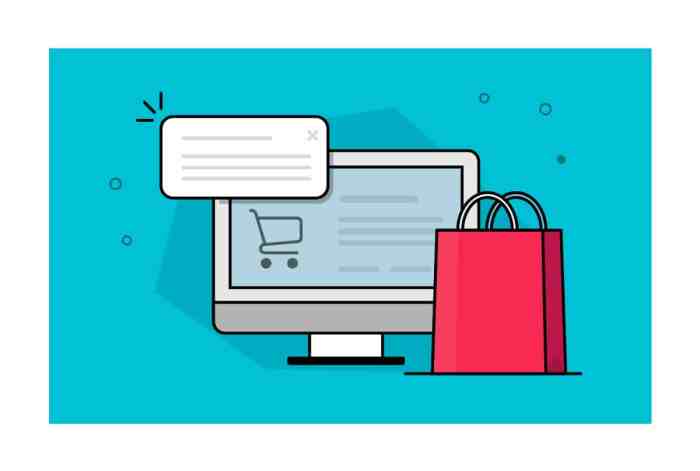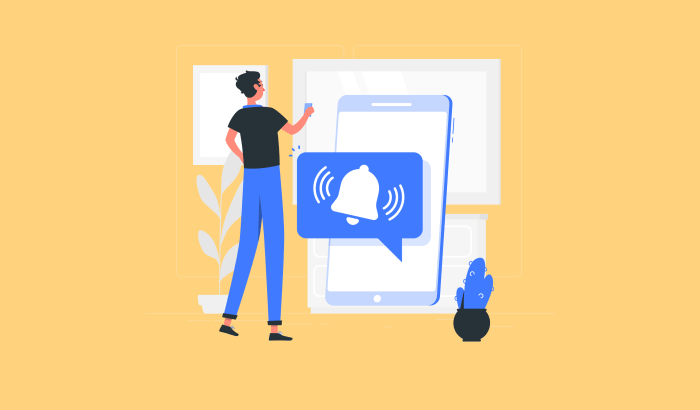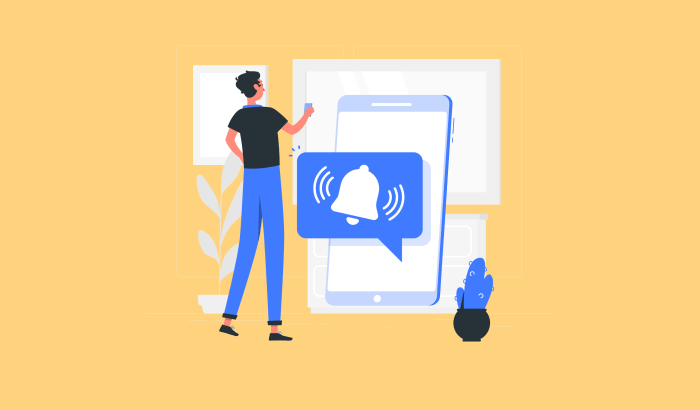Website push notifications for ecommerce are a powerful tool for boosting engagement and conversions. They allow businesses to connect with customers in a timely and relevant manner, delivering targeted messages based on their behavior and preferences. This guide delves into the intricacies of implementing, optimizing, and measuring the impact of push notifications on your ecommerce site.
From understanding the various types of push notifications to exploring the best practices for crafting compelling messages, we’ll cover everything you need to know to maximize the potential of push notifications for driving sales and fostering customer loyalty. We’ll also explore the importance of user consent and privacy, essential aspects for any ecommerce operation.
Introduction to Website Push Notifications in Ecommerce
Website push notifications are a powerful tool for e-commerce businesses to engage with customers and drive sales. They deliver real-time messages directly to users’ browsers, regardless of whether the user is actively browsing the website. This direct communication channel can be highly effective for delivering timely updates, promotions, and crucial information.Push notifications are becoming an increasingly important part of the digital customer experience.
They allow businesses to stay top-of-mind and connect with customers in a way that traditional email marketing or social media updates sometimes can’t match. This immediacy and directness can lead to higher engagement and conversion rates.
Types of Push Notifications in Ecommerce
Different types of push notifications serve distinct purposes. Promotional notifications announce sales, discounts, and new product arrivals, while transactional notifications confirm orders, shipping updates, or provide password resets. Informational notifications deliver essential updates, such as website maintenance or important policy changes.
Benefits of Using Push Notifications for Businesses
Push notifications offer several advantages to e-commerce businesses. They enhance customer engagement, boost conversion rates, and drive repeat business. The ability to send targeted messages based on user behavior and preferences makes push notifications a highly effective marketing tool. Moreover, the real-time nature of these messages can be crucial for time-sensitive promotions or urgent updates.
Importance of User Consent and Privacy Considerations
Respecting user preferences and privacy is paramount when utilizing push notifications. Users must explicitly opt-in to receive notifications, ensuring they understand the purpose and frequency of the messages. Clear and concise notification settings should be prominently displayed on the website, allowing users to manage their subscription preferences at any time. Compliance with data privacy regulations, such as GDPR, is essential.
Advantages and Disadvantages of Using Push Notifications
| Advantages | Disadvantages |
|---|---|
| Improved customer engagement and retention. Real-time delivery of important updates, promotions, and notifications. Targeted messages can be tailored to individual user behavior. Increased conversion rates and sales. Cost-effective way to communicate with customers compared to some other marketing channels. | Potential for annoying users if not used responsibly. Users might unsubscribe if notifications are too frequent or irrelevant. Technical issues or poor implementation can lead to user frustration and a negative experience. Requires careful management to avoid overwhelming or alienating users. User opt-in is crucial, and non-compliance with privacy regulations can have severe consequences. |
Implementing Push Notifications for Enhanced User Engagement

Push notifications have become a powerful tool for e-commerce businesses to re-engage customers and drive conversions. By delivering timely and relevant messages directly to users’ devices, businesses can improve customer retention, increase sales, and foster a stronger relationship. This approach goes beyond simple alerts; it’s about creating a more personalized and interactive experience that keeps customers coming back.Effective implementation of push notifications requires careful planning and execution.
This involves choosing the right platform, segmenting users based on their behavior, and crafting compelling messages. The key is to leverage data to deliver valuable content that resonates with individual user preferences, ultimately boosting engagement and driving sales.
Methods for Implementing Push Notifications
Implementing push notifications on an e-commerce website involves several steps. First, integrate a push notification service with your website. This usually involves adding a snippet of JavaScript code to your website’s HTML. This code typically prompts users to opt-in to receive notifications. Next, develop a strategy for sending notifications.
This includes defining the types of messages you’ll send (e.g., promotions, order updates, abandoned cart reminders) and the frequency of these messages.
Push Notification Services and Platforms
Several platforms provide push notification services. These platforms often offer a range of features and pricing options, so it’s essential to choose a platform that meets your specific needs. Some popular platforms include:
- Firebase Cloud Messaging (FCM): A robust platform offering comprehensive features for sending push notifications, often integrated with other Firebase services, making it a popular choice for developers. FCM provides tools for segmenting users, personalizing messages, and analyzing notification performance.
- Pushwoosh: This platform is designed to manage and send push notifications across various devices and operating systems. It offers comprehensive tools for campaign management and analytics.
- OneSignal: A popular choice, known for its ease of use and extensive features. OneSignal allows for real-time tracking and analysis of push notification performance, enabling businesses to optimize campaigns effectively.
- Amplitude: This platform goes beyond basic push notifications by providing detailed analytics and user engagement insights. Amplitude is well-suited for e-commerce businesses that want to track the impact of push notifications on key metrics.
User Segmentation Strategies
Segmenting users based on their interests and purchase history is crucial for crafting targeted and effective push notifications. This involves categorizing users into groups based on shared characteristics, such as their preferred products, purchase frequency, or abandoned cart activity. By understanding the different segments, businesses can tailor their messages to specific needs and preferences.
Crafting Effective Push Notification Messages
Crafting effective push notification messages is key to driving engagement. Messages should be concise, clear, and compelling, using a tone that resonates with the target audience. Use compelling subject lines and avoid overly promotional language. Adding urgency or exclusivity can also be effective, especially for time-sensitive offers.
Personalizing Push Notifications
Personalizing push notifications is essential for improving engagement. Leveraging user data, such as purchase history and browsing behavior, allows for tailored messages. For example, a notification reminding a user about an item they viewed but didn’t purchase, or offering a discount on a similar product, can be highly effective.
Website push notifications are a powerful tool for e-commerce, but getting them right on mobile is crucial. To ensure a smooth user experience, thorough testing is essential. Tools like testing tools for mobile ux can help you identify and fix any usability issues before they impact conversions. Ultimately, understanding how users interact with your mobile push notifications is key to maximizing their effectiveness.
Push Notification Platform Comparison
| Platform | Features | Pricing |
|---|---|---|
| Firebase Cloud Messaging (FCM) | Robust features, integrated with Firebase, detailed analytics | Free tier for basic usage, paid tiers for increased capacity |
| Pushwoosh | Comprehensive campaign management, cross-platform support | Variable pricing based on usage and features |
| OneSignal | Ease of use, real-time analytics, customizable templates | Free tier for basic usage, paid tiers for advanced features |
| Amplitude | Detailed analytics and user engagement insights, advanced segmentation | Variable pricing based on usage and features |
Optimizing Push Notifications for Conversions: Website Push Notifications For Ecommerce
Push notifications, when implemented effectively, can significantly boost conversions in e-commerce. They provide a direct line of communication with customers, enabling businesses to promote timely offers, re-engage with inactive users, and drive sales. This section delves into strategies for optimizing push notification campaigns to maximize their impact on conversion rates.Effective push notifications aren’t just about sending messages; they’re about understanding user behavior and tailoring communication to resonate with individual needs.
The key lies in understanding the nuances of how push notifications influence conversions, from crafting compelling subject lines to implementing targeted triggers.
Website push notifications are a game-changer for e-commerce, letting you connect with customers directly and drive sales. But unlike traditional marketing, which often feels like a one-way broadcast, the way SaaS marketing works is quite different, requiring a deeper understanding of your customer’s needs and preferences. How SaaS marketing is different highlights the key distinctions.
Ultimately, strategically using push notifications leverages the power of customer relationships to improve conversion rates and loyalty, much like a well-executed SaaS marketing strategy.
Factors Influencing Push Notification Effectiveness
Push notifications effectiveness hinges on several key factors. The relevance of the message to the recipient is paramount. A notification about a sale on shoes will resonate better with a user who frequently browses shoe categories than one who has never shown interest. Timing is equally crucial. Sending a notification during the user’s peak shopping hours or when they are most likely to make a purchase significantly increases the likelihood of a conversion.
The clarity and brevity of the message are also important, avoiding overly complex language or excessive information. Ultimately, the tone and style should align with the brand’s overall identity.
Promoting Specific Products or Offers, Website push notifications for ecommerce
Push notifications offer a powerful platform for promoting specific products or offers. Consider incorporating compelling visuals, highlighting key features, and providing clear calls to action. For example, a notification about a limited-time discount on a particular product should prominently display the discounted price and a button urging the user to “Shop Now.” Furthermore, personalized recommendations based on browsing history can significantly increase the effectiveness of these promotions.
Utilizing A/B Testing for Optimization
A/B testing is essential for optimizing push notification campaigns. Experiment with different subject lines, message content, and call-to-action buttons to identify what resonates best with your target audience. Track key metrics like open rates, click-through rates, and conversion rates to assess the performance of each variation. Regular A/B testing allows for continuous improvement and ensures that your push notification strategy remains aligned with current user preferences.
Triggering Push Notifications Based on User Behavior
User behavior provides valuable insights for crafting effective push notification strategies. Triggers based on abandoned carts allow for immediate re-engagement, reminding users of items left behind and offering incentives to complete the purchase. Similarly, browsing history enables targeted promotions based on past interests, increasing the relevance and perceived value of the notification. For example, if a user frequently views specific electronics, sending a notification about a sale on similar products will likely yield better results.
Examples of Effective Push Notification Subject Lines
| Subject Line | Message | Target Audience |
|---|---|---|
| 🔥 Limited-Time Offer! 20% Off! 🔥 | Get 20% off selected items. Offer ends soon! | General shoppers |
| Just for You: [Product Name] is on Sale! | Special offer on [Product Name] you’ve been looking at. | Users who have previously viewed the product |
| Almost forgot! Your [Product Name] is waiting! | Don’t miss out on your abandoned cart. | Users with abandoned carts |
| New Arrivals! See what’s fresh! | Explore new products added to our store. | General shoppers |
| Free Shipping on Orders Over $50! | Enjoy free shipping on orders above $50. | Users who have previously ordered or are about to order |
Measuring the Impact of Push Notifications
Knowing how your push notifications perform is crucial for optimizing your ecommerce strategy. Understanding which messages resonate with your audience and which fall flat is key to maximizing engagement and driving conversions. Without data-driven insights, your push notification efforts might be working in the dark, wasting valuable resources.This crucial step involves analyzing the quantitative and qualitative feedback from your users to fine-tune future campaigns.
By tracking specific metrics, you can identify what works and what doesn’t, ensuring your push notifications are effective tools for boosting sales and fostering customer loyalty.
Key Performance Indicators (KPIs) for Push Notifications
Understanding the metrics that matter most for push notification success is fundamental. Tracking these key performance indicators (KPIs) provides valuable insight into the effectiveness of your campaigns.
- Click-Through Rate (CTR): This metric measures the percentage of users who click on a link within a push notification. A high CTR indicates that your message is engaging and relevant to your audience, prompting them to take action. For example, a push notification offering a 20% discount on a specific product will likely have a higher CTR if the target audience is actively searching for that product category.
- Open Rate: This is the percentage of users who open a push notification. A high open rate suggests that your message is captivating enough to prompt users to interact with it. Consider the timing and frequency of your notifications; overly frequent or irrelevant notifications can lead to a low open rate.
- Conversion Rate: This KPI measures the percentage of users who complete a desired action, such as making a purchase, after clicking on a push notification link. A high conversion rate signifies that your notifications are effectively driving sales and demonstrating a strong return on investment (ROI). For instance, a push notification highlighting a limited-time sale might have a higher conversion rate than a general notification.
Analyzing Data to Improve Future Campaigns
Data analysis is the cornerstone of refining your push notification strategy. By examining the collected data, you can identify trends, patterns, and areas for improvement.
Website push notifications are a game-changer for ecommerce stores. They’re a fantastic way to re-engage customers and boost sales. However, sometimes you need a little extra nudge to get those sales conversions flowing. That’s where strategies like better results facebook ads come in handy. Integrating targeted Facebook ad campaigns can significantly improve your reach and, in turn, lead to a higher volume of returning customers.
Ultimately, a well-rounded approach using push notifications in conjunction with effective Facebook ad campaigns is key to maximizing your ecommerce success.
- Segmenting Users: Group users based on their behavior and preferences. This enables personalized push notifications, increasing engagement and conversion rates. For example, users who frequently browse a specific product category can receive targeted notifications about new arrivals or promotions related to that category.
- A/B Testing: Experiment with different notification content, subject lines, and timing. Analyze the results to determine which variations yield the best performance. Testing different subject lines or images can provide significant insights into what resonates best with your target audience.
- Identifying Trends: Observe patterns in the data to understand what types of notifications are most effective. This can help you tailor future campaigns to focus on successful formats and messaging.
Push Notification Metrics Tracking Table
This table summarizes the key push notification metrics and how to track them.
| Metric | Description | How to Track |
|---|---|---|
| Click-Through Rate (CTR) | Percentage of users who click on a link within a notification. | Use website analytics tools (e.g., Google Analytics) to track clicks from push notifications. |
| Open Rate | Percentage of users who open a notification. | Use notification platform analytics to measure open rates. |
| Conversion Rate | Percentage of users who complete a desired action (e.g., purchase) after clicking on a notification. | Use website analytics tools to track conversions attributed to push notifications. |
| Bounce Rate | Percentage of notifications that fail to deliver. | Use notification platform analytics to identify failed delivery attempts. |
| Engagement Rate | Overall interaction with notifications (clicks, opens, etc.). | Combine CTR, open rates, and other relevant metrics. |
Case Studies and Best Practices

Push notifications have become a powerful tool in the ecommerce arsenal, but their effectiveness hinges on strategic implementation. Understanding successful campaigns and common pitfalls is crucial for maximizing engagement and conversions. This section delves into real-world examples, highlighting best practices and strategies employed by leading ecommerce companies, along with crucial mistakes to avoid.Real-world examples demonstrate that targeted, timely, and engaging push notifications can significantly boost sales and customer loyalty.
Effective campaigns often involve a combination of factors, including personalization, clear calls to action, and a deep understanding of user behavior.
Successful Ecommerce Push Notification Campaigns
Effective push notification campaigns are not one-size-fits-all. Understanding different strategies employed by leading companies allows us to learn from their successes. Here are some key examples of campaigns across various sectors:
- Fashion Retailer Campaign: A popular fashion retailer used push notifications to promote exclusive discounts on limited-edition items. By targeting users who had previously shown interest in specific styles, they achieved a 20% increase in conversion rates on these limited-edition products. This highlights the power of personalization.
- Electronics Retailer Campaign: An electronics retailer used push notifications to alert customers about new product releases and special promotions. This approach successfully drove traffic to product pages and increased sales by 15% during product launches.
- Subscription Box Company Campaign: A subscription box company utilized push notifications to remind customers about upcoming deliveries and offer incentives for early renewals. This strategy led to a 10% increase in renewal rates and boosted customer lifetime value.
Common Mistakes to Avoid in Push Notifications
Many companies make costly errors when implementing push notifications. Understanding these mistakes is key to building successful campaigns.
- Sending too many notifications: Bombarding users with irrelevant or frequent notifications leads to user frustration and unsubscribes. The key is to carefully segment your audience and tailor your messaging to specific user needs.
- Ignoring user preferences: Failing to respect user preferences and settings (like opting-out) is a critical mistake. A user-centric approach that prioritizes user choice and provides clear opt-out mechanisms is essential.
- Poorly designed notifications: Notifications that lack clear calls to action, compelling visuals, and relevant information are less effective. A concise, visually appealing design is crucial for catching attention and driving engagement.
- Lack of personalization: Generic notifications that don’t consider user preferences or past behavior fail to resonate with the target audience. Tailoring messages to specific segments, based on purchase history, browsing behavior, and other user data, significantly increases the likelihood of conversions.
Detailed Example of a Successful Campaign
A shoe retailer, “SoleMates,” ran a campaign to promote a seasonal sale. Their objective was to increase sales of winter boots by 15% during the November-December period.
- Objectives: Increase sales of winter boots by 15% during November and December.
- Implementation:
- Segmented users based on past purchase history (showing interest in winter footwear).
- Sent targeted notifications with visually appealing images of winter boots and a clear “Shop Now” call to action.
- Included a countdown timer in the notifications to create urgency.
- Offered exclusive discounts to segmented users.
- Tracked key metrics (clicks, opens, conversions).
- Results: SoleMates exceeded their goal, achieving a 20% increase in winter boot sales during the targeted period. The campaign highlighted the importance of segmenting users, using high-quality visuals, and incorporating clear calls to action.
Future Trends in Ecommerce Push Notifications
Ecommerce push notifications have become an integral part of the customer experience, enabling businesses to engage with customers effectively and drive conversions. As technology evolves, the future of these notifications is poised for exciting advancements, presenting both opportunities and challenges for businesses. Understanding these emerging trends is crucial for retailers to stay ahead of the curve and leverage the full potential of this powerful marketing tool.The use of push notifications in e-commerce is constantly adapting to the changing needs of customers and businesses.
Innovations in technology are pushing the boundaries of what’s possible, from personalized content delivery to real-time engagement. This evolution will bring both opportunities and challenges that savvy businesses will need to navigate successfully.
Personalized and Contextual Notifications
Personalized push notifications are becoming increasingly sophisticated. This involves leveraging data from customer interactions, purchase history, and browsing behavior to tailor messages. For example, a customer who frequently browses shoes might receive notifications about new arrivals or sales on that specific category. Similarly, abandoned cart reminders can be highly personalized with special offers relevant to the items left in the cart.
These personalized experiences enhance customer engagement and improve conversion rates.
Real-time Updates and Dynamic Content
Real-time updates and dynamic content within push notifications are another key trend. This allows businesses to inform customers about events such as limited-time sales, product restocks, or even in-store promotions. Imagine a notification popping up immediately when a customer’s desired product becomes available after a period of being out of stock. Dynamic content can also reflect current events or seasonal trends, further enhancing the relevance and engagement of push notifications.
Integration with Other Channels
The future of push notifications lies in their seamless integration with other marketing channels. This includes social media, email marketing, and in-app messaging. A consistent brand experience across all platforms is crucial for effective communication and building brand loyalty. For example, a notification might direct the user to a specific product page on the website, or offer a discount code for a purchase.
Advanced Segmentation and Targeting
Advanced segmentation and targeting techniques will be employed to deliver highly targeted messages. Businesses will utilize sophisticated algorithms to identify customer segments based on various factors, such as demographics, purchase behavior, and engagement levels. This targeted approach will enable businesses to personalize the customer experience and boost engagement. Consider a notification specifically targeting customers who haven’t made a purchase in the last three months, offering a special discount.
Augmented Reality (AR) and Immersive Experiences
The integration of augmented reality (AR) and immersive experiences into push notifications represents a significant potential for innovation. Notifications might include interactive elements that allow customers to virtually try on clothes, visualize furniture in their homes, or explore products in 3D. This immersive experience enhances the shopping experience and provides a unique value proposition.
Table of Potential Future Trends in Ecommerce Push Notifications
| Trend | Description | Impact |
|---|---|---|
| Personalized and Contextual Notifications | Tailoring notifications based on individual customer data. | Increased engagement, improved conversion rates. |
| Real-time Updates and Dynamic Content | Providing immediate updates on sales, product availability, and other relevant events. | Enhanced customer experience, increased urgency and relevance. |
| Integration with Other Channels | Seamlessly connecting push notifications with other marketing channels. | Consistent brand experience, improved customer journey. |
| Advanced Segmentation and Targeting | Identifying and targeting specific customer segments for personalized messaging. | Higher conversion rates, improved customer satisfaction. |
| Augmented Reality (AR) and Immersive Experiences | Incorporating AR and immersive elements into push notifications. | Enhanced shopping experience, unique value proposition. |
Closing Summary
In conclusion, website push notifications for ecommerce can significantly enhance user engagement and drive conversions if implemented strategically. This guide has provided a comprehensive overview, from the fundamentals to advanced strategies. By understanding the various types of notifications, implementing effective segmentation and personalization, and meticulously measuring campaign performance, you can leverage push notifications to build a more robust and profitable ecommerce presence.








